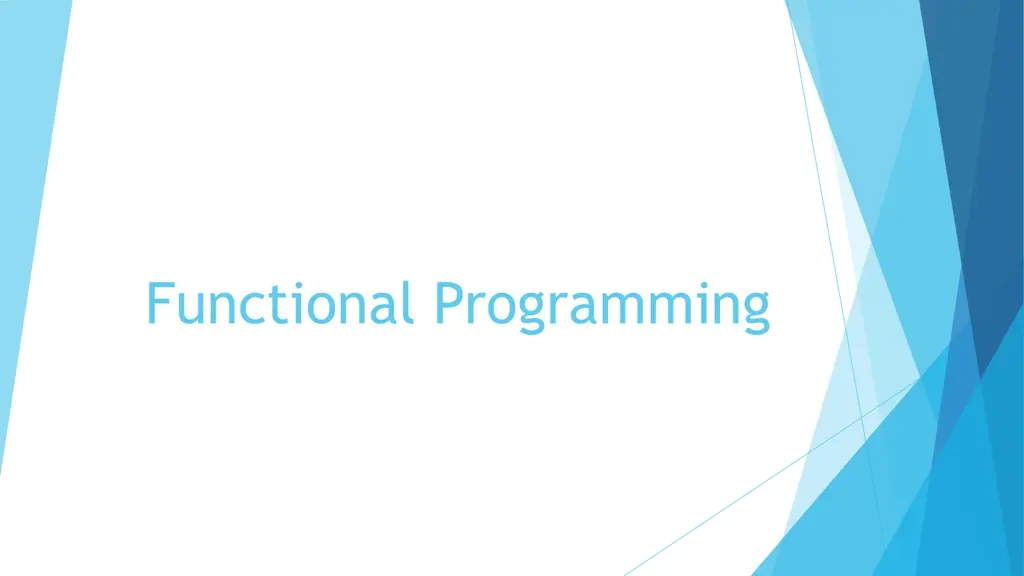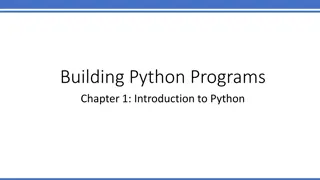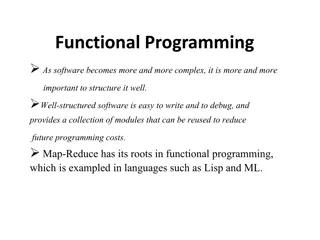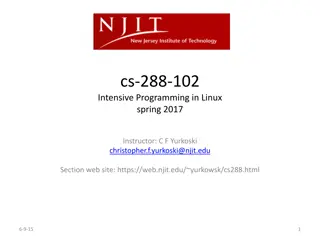Functional Programming
Functional programming, a paradigm that emphasizes declarative programming, pure functions, and limited side effects. Explore the benefits and characteristics of functional programming languages.
Download Presentation

Please find below an Image/Link to download the presentation.
The content on the website is provided AS IS for your information and personal use only. It may not be sold, licensed, or shared on other websites without obtaining consent from the author.If you encounter any issues during the download, it is possible that the publisher has removed the file from their server.
You are allowed to download the files provided on this website for personal or commercial use, subject to the condition that they are used lawfully. All files are the property of their respective owners.
The content on the website is provided AS IS for your information and personal use only. It may not be sold, licensed, or shared on other websites without obtaining consent from the author.
E N D
Presentation Transcript
Side effects A side effect is when something happens as a result of calling a function besides just returning a value. The most common side effect is logging to the console, via the built-in print() function. print(-2) A similar side effect is writing to a file: f = open('songs.txt', 'w') f.write("Dancing On My Own, Robyn") f.close()
Side effects vs. Return values def square_num1(number): return pow(number, 2) def square_num2(number): print(number ** 2) Which one has a side effect? The second function has a side effect, because it prints to the console. What data type do they each return? The first function returns a number, the second one returns None.
Pure vs. non-pure functions In programming, we can talk about pure vs. non-pure functions Pure function no side effects Non-pure function has side effects
Benefits of pure functions Pure functions provide several benefits The output of a function is only dependent on its input and is repeatable same input always means the same output can't influence or be influenced by external "state" This is great for math and mathematical proofs Functions can be tested and verified independent of one another which makes testing easier Code is easier to parallelize since it doesn't depend on anything else or affect anything else, it can be run in isolation
Functional Programming "Functional programming" is a paradigm that strives to achieve all the benefits of using pure functions in the execution of code. The chief characteristics of functional programming are: Programs are more declarative instead of imperative Functions as first-class objects & higher-order functions Limited or no side-effects Immutability of objects Recursion for control flow While many (or even most) modern languages support the functional programming paradigm, there are many languages where this it the core programming style e.g. Haskell, Erlang, Clojure, Common Lisp, and Scala
Why functional programming? Can be much easier to test and validate Code is often simpler and more modular Code written in a functional programming (FP) style is easier to parallelize FP style is heavily used in the machine learning and big data fields Many modern development frameworks are written in a functional style
Functional programming downsides More mathematically based and the vocabulary can be intimidating Programs can sometimes be harder to read and understand Can potentially require more time and/or memory space to execute Can't be used everywhere (database connections, servers, etc.) You really need to understand recursion
Characteristics of Functional programming Let's look at some of the characteristics of functional programming. We've already seen some of them in this class Functions as first-order objects Higher-order functions Side effects and pure vs. impure functions (today) The new topics include: Declarative vs imperative programming (today) Function composition (today) Immutability of objects (next lecture) Recursion (after the midterm)
Declarative vs. Imperative programming
Declarative programming In imperative languages: A "program" is a description of computational processes The interpreter carries out execution/evaluation rules In declarative languages: A "program" is a description of the desired result The interpreter figures out how to generate the result
Domain-specific languages Many declarative languages are domain-specific: they are designed to tackle problems in a particular domain, instead of being general purpose multi-domain programming languages. Language Domain Regular expressions Pattern-matching strings Backus-Naur Form Parsing strings into parse trees SQL Querying and modifying database tables HTML Describing the semantic structure of webpage content CSS Styling webpages based on selectors Prolog Describes and queries logical relations
Display an image Declarative vs. Imperative Python from byuimage import Image HTML <html> <p>Hello</p> <img src="profile.jpg"> <html> print("Hello") img = Image("profile.jpg") img.show() The imperative language (Python) tells the computer what to do at each step to print a message and display an image. Import the image library, print the message, load the image, display it The declarative language (HTML) just tells that compute that it wants the message displayed and then an image. The language worries about how that is done.
Function composition Functional composition is the process of combining simpler, pure functions into a more complex function. The results of the first function becomes the input to the second and the results of the last function is the result of the whole. Mathematically this looks like result = f(g(x)) Functions can be combined as needed to do more complex tasks It's easy to test the simple base functions and therefore verify that the complex task is performed correctly.
Example: Composer def happy(text): return " " + text + " " def sad(text): return " " + text + " " def composer(f, g): def composed(x): return f(g(x)) return composed msg1 = composer(sad, happy)("CS 111!") msg2 = composer(happy, sad)("CS 240!") What do you think will happen? View in PythonTutor
Example: Composer (part 2) One of the composed functions could itself be an HOF... def happy(text): return " " + text + " " def make_texter(emoji): def texter(text): return emoji + text + emoji return texter def composer(f, g): def composed(x): return f(g(x)) return composed View in PythonTutor composer(happy, make_texter(" "))('snow day!')























